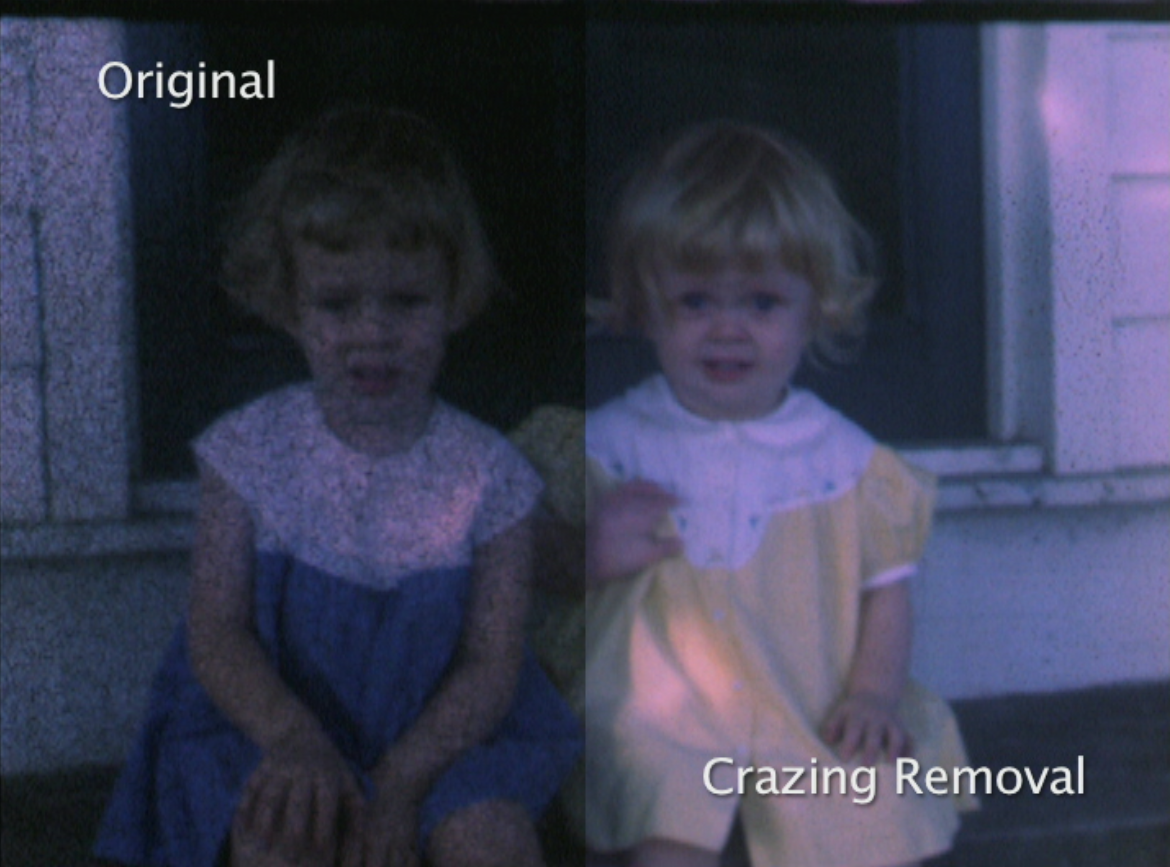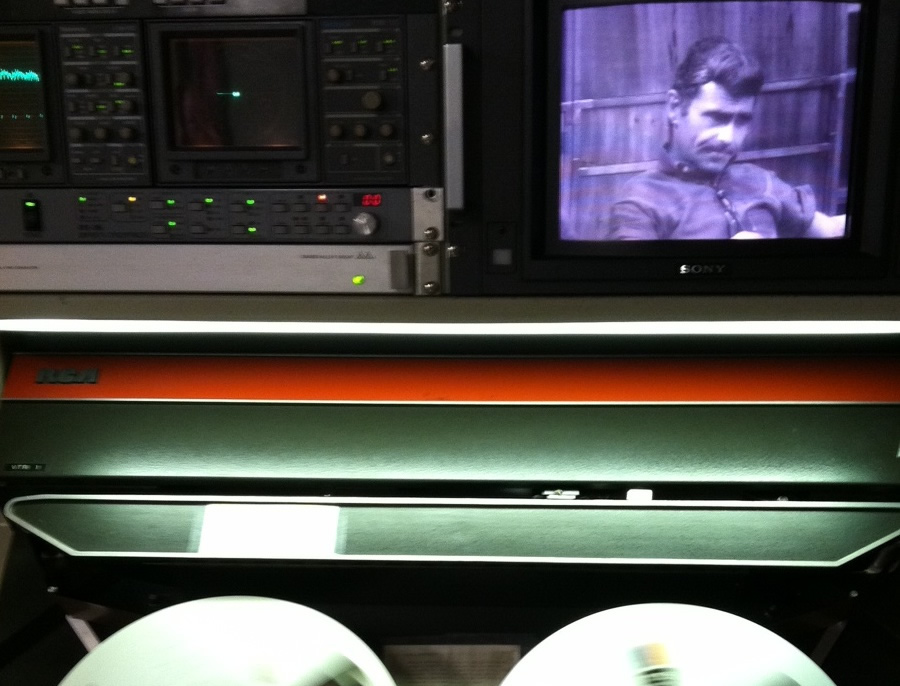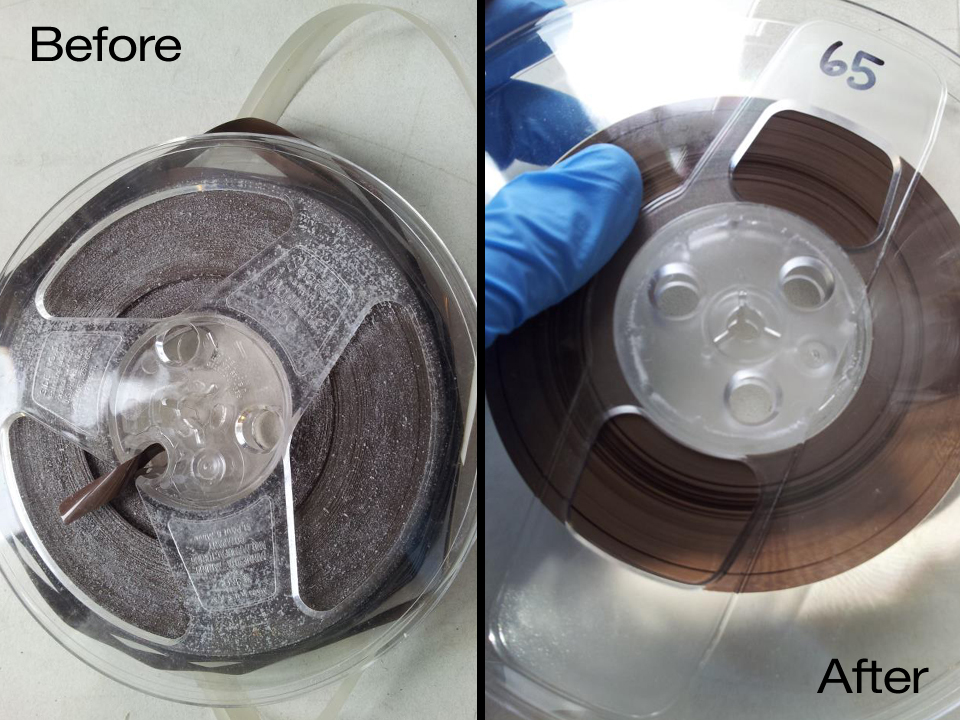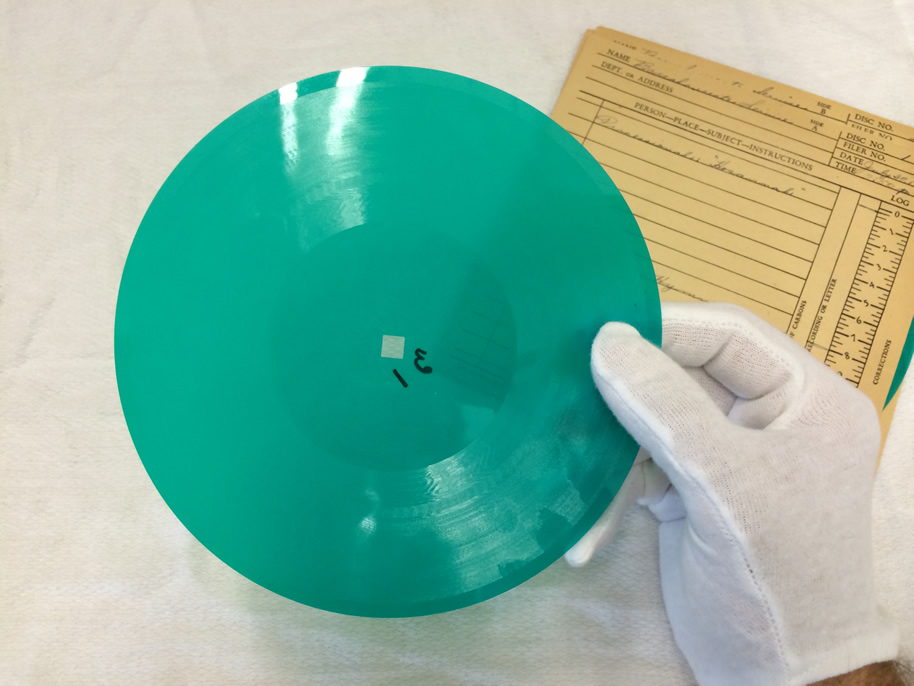1" videotape | There were several types of 1" videotape, including Type A, Type B and Type C. These are not interchangeable. Type C was the most popular format, and was introduced in 1976. It was a "compromise" (hence Type C) between the two competing formats offered by Sony and Ampex. Ampex introduced the Type A in 1965, and Bosch introduced the Type B in 1976. |
16mm | Professional and amateur. Introduced by Kodak in 1923. Measures 16 millimeters in width. |
2" videotape | Introduced in 1956 by Ampex, it used four record heads and recorded the video signal to a 2" wide, reel based videotape. Also called Quadraplex or simply Quad |
3/4" videotape | 3/4" videotape cassettes were introduced in 1970 by Sony, JVC and Matsushita, and became one of the most successful videotape formats of all time. It was introduced originally as "low band" with 280 lines of resolution, then later as "high band" with improved color. In 1986, SP (Superior Performance) was introduced, with 340 lines of resolution. Also known as U-Matic. |
35mm | Primarily professional. Introduced in 1895. Measures 35 millimeters in width. |
8mm | Primarily amateur. Introduced by Kodak , 1932. Film stock is 16mm, the split into two 8mm strips following processing. Measures 8 millimeters in width. |
A and B Rolls | Paired production elements that are printed in succession to hide transitions or splices between shots to produce dissolves or fades. Created by splicing negative or positive film into two rolls. Where one carries the picture, the other has black or blank leader. |
A or B Wind | When a roll of 16mm film, perforated along one edge, is held so that the outside end of the film leaves the roll a the top and toward the right, winding "A" should have the perforations on the edge of the film toward the observer, and winding "B" should have the perforations on the edge away from the observer. In both cases, the emulsion surface should face inward. |
Acetate | Type of film base. May be di- or tri- acetate. Cellulose tri-acetate is more common for modern film. Acetate safety film was first produced in the 1920s in order to avoid the risk of flammability posed by nitrate based film. |
Analog Videotape | Videotape that requires sound and image information using frequency-modulated signals. |
Audiovisual | Audiovisual means "of or relating to both hearing and sight". Pertaining to audiovisual collections, the term typically means film, video and sound recordings, regardless of the format of those recordings. |
BetaCam SP Videotape | BetaCam (also called Beta) is an analog videotape format originally developed by Sony in 1982. It uses a 1/2" videotape cassette and records/plays a component video signal, with 300 lines of video resolution. In 1986, Sony introduced the SP format, which stands for Superior Performance with 340 lines of video resolution. |
Binder Shed | When videotapes experience hydrolysis, the binder begins to lose its adhesive properties, allowing the oxide from the tape to be stripped off during playback. This causes several problems, including clogged videotape playback heads and can render the tape completely unplayable. |
CCD | Charge Coupled Device. CCDs are used in digital cameras to convert light to electronic signals. They are used in digital cameras to convert light to the appropriate digital information for recording on storage tapes or disks. |
Component Video | Component video signals retain maximum luminance and chrominance bandwidth, resulting in better quality video signal. This is due to the separation of the analog, or digital components into three different channels. |
Composite Video | In composite video, the luminance and chrominance are combined. Literally, the color is added to the monochrome information (added to luminance). Since the human eyes have a greater ability to perceive luminance than color, the color sharpness is reduced far below luminance, which is great for transmission of the video signal. Composite video is an analog form of video and is not as high a quality as component video. |
Conservation | Actions taken to ensure the continues physical survival of an artifact without further degradation, for example, storing your material in archival containers and in cold vaults. |
Constant bit rate compression | A compression scheme that maintains a constant data rate, regardless of the complexity of the video. The advantage is you will have a known size for a given length of video, but resources such as storage can be "wasted" on simple video, or the quality of video can be reduced for "complex" video. |
Control Track | A linear track recorded onto a videotape used for the positioning or reading of the video tracks, and to drive a tape counter. It is the magnetic equivalent to sprocket holes in film. Without control track, videotapes would be unplayable. |
Core | Hub on which the film is wound for storage. Usually plastic. |
D-1, D-2, D-3 and D-5 Videotape | D-1 was the first practical digital VTR, introduced by Sony in 1986. Although still considered a high-quality reference, D-1 is expensive to buy and use and has been mostly superseded by the more cost effective later formats. D-2 was developed by Ampex and Sony around the same time as D-1 was introduced and was meant to be a fully transparent storage for composite video (as compared to component video), but improvements in component television reduced interest in a composite format.. D-3 and D-5 have both been developed by Panasonic/Matsushita. D-3 was designed to compete against D-2, and was a high-quality format with 450 lines of resolution. D-5 is a component, non-compressed digital format, developed in 1994 . A high definition version of D-5 (D-5 HD) has been introduced by Panasonic. It uses 4:1 compression in order to accomodate the 1.2 Gbps HDTV data rate. It can work with both 1080 line interlaced or 720 line progressive (American) HDTV formats. |
Data Rate | The amount of data transferred per second by a computing or storage device. For video compression, the data rate is typically measured in kilobits per second (kbps) or megabits per second (mbps). The higher the data rate, the more data is collected per second, which means the higher the data rate, the better the resulting quality of the digital file. Can also be used to describe audio compression and transfer speed of telecommunications devices. |
Degradation | The chemical process where a material (molecules) seeks to become more stable. For example, the binder on videotape absorbs hydrogen from the environment (like humidity in the air) to become a more stable molecule. During this process, it loses its adhesive properties, becoming sticky and soft. Film acetate reacts with moisture in the air to form acetic acid, which gives off the characteristic odor of vinegar. |
Digital Asset Management | A digital asset management system is simply a tool used to organize and describe assets that are in a digital form (such as digital video files or digital audio files). It is used to facilitate search, retrieval and access to the assets. Within a digital asset management system, the digital files may be linked to the physical asset in storage, but a pure digital asset management system relates specifically to the digital file. |
Digital BetaCam Videotape | Sony introduced the Digital BetaCam format in 1993, which uses physically similar half-inch cassettes to the BetaCam SP machines. Many Digital Beta units can automatically detect analog (BetaCam SP) or digital tape formats, and can play back, but not record analog Beta SP tapes. |
Digital Color Correction | The process of enhancing or restoring the color to a film or video. |
Digital Color Corrector | The equipment used to restore or enhance the color of a film or video. Rather than affecting the color of the source material, it enhances the color of the signal from the original so that the resulting copy contains the improved color. Color Correction systems are often used to restore color to film that has faded due to age, or to correct color and brightness that may have been caused by improper camera settings during the original shoot. Digital color correction can also be used when reformatting videotapes. |
Digital Videotape | Videotape that stores picture and sound as numeric values. |
DV (video) | DV, or Digital Video is a digital videotape format that uses a 5:1 compression ratio to record component digital video. Video recording rate for DV video is about 25 Megabits per second, except for DV-50, which uses a higher data rate of 50 Mbps. There are different brands referred to by different names, and not all are interchangeable. DVCAM is Sony's version and DVC Pro is Panasonic's version |
DVD | Digital Versatile Disk (sometimes also called Digital Video Disk, which is really a misnomer). It is the same size as a CD, but offers higher density, allowing up to 4.75 GB of information to be stored on a single-sided, single-layer disk. |
DVD Storage Capacity | DVD disks are flexible in terms of the amount of material they can store. Sometimes the storage capacity of a DVD is represented as a number following the type of disk. For example, a DVD-5 is a 4.75 GB ( roughly 5 GB) capacity disk, which is single side and single layer. A DVD-9 is a single-side, dual layer disk with roughly 9 GB of storage capacity, where the laser that reads the information first focuses on one layer, then on the second layer to read the data. A DVD-10 is a double side, single layer disk, where the disk physically has to be flipped over to read the other side. |
DVD Types | There are different types of DVDs, including recordable DVDs (DVD-R, DVD+R, DVD RAM) and replicated DVDs. DVD-R, +R and RAM disks are created when a laser in the DVD writer changes the physical properties of a dye layer within the DVD disk to create pits and grooves that can be read later in a DVD drive, or player. Replicated DVDs are what you see when watching a Hollywood movie, where the "image" of grooves on the disk is physically pressed into the disk from a "master" disk and then coated with a reflective material (usually silver or aluminum). Replicated disks are not cost effective or practical for small quantities. |
Edge Code | Symbols printed along the edge of the film by the manufacturer to indicate production data, such as date and location of manufacture. |
Film Base | The carrier, or substrate, upon which the emulsion and image forming materials is transported. Film base is a tough transparent polymer often an ester of cellulose or polyester. |
Film Cleaning | Film cleaning is the removal of dirt, dust, oil, fingerprints, and other soil from the surface of a film. The process may be "wet" and use aqueous solutions or solvents that are proven to be safe for the film (i.e. the base, emulsion, and image forming material) or "dry" with methods ranging from simple "dusting back" with a clean cloth to the slightly sticky Particle Transfer Roller (PTR). |
Flange Pack | Pack is the smoothness and tension of the "wind" of videotape or film on a reel. Flange pack occurs primarily due to misalignment during playing, fast forwarding or rewinding, or can occur from allowing a tape to be stored laying flat. It means the tape wind has come to rest against one of the flanges of the supply, or take up reel. This could cause edge damage or curling to the tape, and can affect subsequent playback |
Format Obsolescence | Videotape formats have changed numerous times since the inception of Videotape. Since videotape requires a specific type of machine to play, as manufacturers stop making the equipment, and as existing machines break down or are discarded, the older formats become obsolete. |
Gauge | Refers to the format/width (in millimeters) of the film stock, i.e. super 8, 16mm, or 35mm. |
Generation Loss | Sometimes also called Generational loss. It is the loss in signal quality incurred when copying materials. Applies to analog recordings, but not digital, unless the digital recording uses compression and requires decompression and recompression to duplicate the content (such as happens when editing formats that use compression) |
Head | The beginning of a film or tape. |
Hub | The center of a film or tape reel. |
Hydrolysis | The technical description of "hydrolysis" is the chemical decomposition involving the splitting of a bond (within a molecule) and the addition of hydrogen or water. This process is typically used to describe a form of decomposition that videotape undergoes where the binder on the tape base absorbs water from the surrounding environment, and loses its adhesive properties. |
Index | For purposes of archiving, the term "index" is used as a verb and means creating information about that asset, which can be used to describe the asset. This may include metadata, key frames, closed captioning, spoken words or information about the condition of the original asset. |
Inert | Does not react chemically. |
Inspection | Close examination of film or tape to identify technical characteristics and physical condition. |
Interframe Compression | A video compression format based on a mathematical algorithm where differences and similarities between frames of video are compared and only the differences are saved. The similar information is re-created from frame to frame, making this an incredibly efficient compression format. While it enables you to maintain relatively good quality with small file sizes, the nature of interframe compression makes this a difficult format to edit, and subject to artifacts during playback (decoding), particularly for complex or fast motion video. As an example, MPEG 1 and MPEG 2 use interframe compression. |
Intraframe compression | A compression format where only the information contained in the individual frame is compressed. Since all frames can be saved, it is a good compression format if it is to be edited in the future, but it is not a very efficient compression format. In order to achieve high quality, files are large. To significantly reduce the file size, often frames are discarded, with the resulting video files playing back at less than full motion. JPEG and MPEG "I-frame only" are examples of intraframe compression. |
Leader | Any film or strip of plastic or vinyl attached to the ends of a reel of film or magnetic tape. The leader is used to threading a motion picture machine. It protects the area containing content from damage during threading and handling. |
Magnetic (acetate) | Magnetic full-coat or stripe with a cellulose base. |
Magnetic (polyester) | Magnetic full-coat or stripe with a polyester [PET] base. |
Magnetic Sound | Soundtrack derived from an electronic audio signal recorded on a magnetic oxide stripe or on a full coated magnetic tape. |
Media Asset Management | Often used interchangeably with "digital asset management", it is really a subset of digital asset management. Whereas digital asset management describes all types of digital files, media asset management describes media files, including audio and video. Media asset management often includes metadata specific to the source media, including key frames, closed captioning, spoken words and "on-screen" text) |
Metadata | Metadata is literally "data about data". It describes the content, quality, condition and other characteristics of data. We use the term a little more loosely in that we use it to describe the characteristics of physical objects, as well, including the films and videotapes along with the content they contain. This data is useful for future research, search and retrieval and can be included in a digital asset management system to describe the individual assets contained in the system |
Mildew | Mildew is a fungus which thrives in moist or humid environments. See Mold. |
Mold | Mold is a fungus, which produces tiny spores to reproduce. When these spores contact a moist surface, they can attach themselves and begin growing, in the process digesting whatever surface they are attached to. There is no way to completely eliminate mold spores in the air or environment. The way to control mold is to control moisture. |
MPEG 1 | MPEG stands for "Moving Picture Experts Group", which is the name of a group of standards used to define coding of audio/visual information in a compressed digital format. MPEG 1 is a compression standard designed for low to medium bandwidth applications. Data rates range from about 100 Kbps up to 5 Mbps. |
MPEG 2 | MPEG 2 is an audio-visual compression standard designed for medium to high bandwidth applications, including broadcast (up to HDTV) and DVD. Data rates range from about 4 Mbps up to 100 Mbps. It was not designed as a replacement for MPEG 1 (which still has its uses), but as an addition to MPEG 1. |
MPEG 4 | MPEG 4 is a streaming format designed to handle very low to very high bandwidths (from cel phones to high-definition television). MPEG 4 is an addition to MPEG 1 and MPEG 2, and is designed to enable efficient delivery of audio/visual content over networks, including the Internet and satellite. |
MPEG 7 | MPEG 7 is not a compression format. It is also known as a "Multimedia Content Description Interface", and is a standard for describing the multimedia content data that supports some degree of interpretation of the informations meaning, which can be passed onto, or accessed by, a device or a computer code. MPEG-7 is not aimed at any one application in particular; rather, the elements that MPEG-7 standardizes support as broad a range of applications as possible. For example, MPEG 7 could allow a digital video recorder to automatically start recording a program based on pre-defined criteria about programs you want to capture. It is machine readable information as compared to human readable information, although a machine can "translate" the information to make it human readable. |
Optical Disks | Removable disks that use optical techniques for recording and playback. For example, recordable CDs and DVDs are optical disks. |
Optical Sound | An optical soundtrack is photographically represented along the side of the film as a wavy stripe of clear (variable area) or as gray gradations (variable density). It corresponds to the modulations of the sound. The soundtrack is read by means of an exciter lamp on the projector or telecine which transforms the light back into sound. |
Perforation Damage | Any breaks, tears, cracks, etc. that causes the perforations to be misshapen or missing, causing possible issues with the films transport through equipment. |
Perforations | Regularly spaced and accurately shaped holes which are punched throughout the length of motion picture film. Pins, pegs and sprockets engage these holes as the film is transported through the camera, projector or other equipment. |
Polyester | A name for polyethylene terephthalate. This is a non-organic base for film. It is used nearly exclusively now for 35mm theatrical prints. Also known as Mylar; Cronar is the trade name for Dupont motion picture products; ESTAR Base is the trade name for Kodak products. |
Preservation | Continuum of activities necessary to protect film for the future and share its content with the public. |
Professional Copies | For film and video, professional copies is typically used to reference copies that a professional organization would use (for example, an editorial facility or broadcast television station). It may include making a film copy of a film, or high-resolution copy on videotape. It would include such formats as BetaCam SP and Digital BetaCam, but depending on use, may also include high-resolution digital copies or DVD. |
Proper Storage Environment | Proper storage environment will mean different things to different people, depending on the goals of your facility and the current condition of your materials. For our purposes, it means providing a safe storage environment for your materials, where they are protected from contamination, moisture, temperature and humidity swings, improper handling and potential damage from utilizing equipment that is in poor condition. |
QA/QC | Quality Assessment and Quality Control: Process through which preservationists check the acceptability of the newly created preservation and/or access elements. |
RAID | Redundant Array of Independent Disks. This is a grouping of standard disks drives together in a system together with a RAID controller that creates a storage environment that acts as one disk. The primary objective is to provide performance and redundancy beyond that available from individual drives. The level of protection is referred to as a number, ranging from Level 0 to Level 5 with each level having benefits for particular applications. A higher level is not necessarily better, depending on your application. |
Relative Humidity | The amount of water in the air compared to the maximum amount of water that the air can hold at given temperature. High relative humidity is extremely detrimental to the long-term life of audio-visual collections. |
Remastering | To create a new master of an older recording. When working with Videotape, to change the format of a videotape, typically used when describing the process of copying the content from an older or outdated format to a newer format (for example, copying the content from a 3/4" videotape to a BetaCam SP videotape) |
Restoration | The technical description of restoration is "restoration is an act of restoring or the condition of being restored : as a bringing back to a former position or condition, a restoring to an unimpaired or improved condition <the restoration of a painting>". For our purposes, it includes providing the necessary services required to return a film or videotape (or the contents of such) to its original condition, to remove the effects of degradation. |
Shrinkage | Reduction in dimensions of motion-picture film caused by loss of moisture, support plasticizers, and solvents, as well as heat, use, and age. The film actually shrinks, although often not uniformly. |
Shrinkage Gauge | Device used to measure the extent to which film has contracted from its original dimensions. Compares the standardized distance between perforations with that of the shrunken film and expresses the difference as a percentage. |
Soundtrack (optical or magnetic) | Runs lengthwise on film adjacent to the edges of the image frames and inside the perforations. |
Splice | Joining two pieces of film or magnetic tape to form one piece, either for editing or repair purposes, by use of either adhesive tape, cement or ultrasonic methods. |
Split Reel | A reel used for holding films on cores. The two halves of which may be unscrewed and a core or film on a core placed in the middle. |
Sprocket | Toothed mechanism that engages the film edge, used to advance the film strip through a camera, printer, or projector. |
Step Pack | Can occur from misalignment or improper tension during playing, fast forwarding and rewinding. Wind is uneven and appears "stepped", with certain parts of the pack being higher, or lower than the rest of the pack. Sometimes also called Popped Strands where a single wind of tape sticks out from the rest of the pack.. |
Storage Requirements (for video) | Storing uncompressed video requires a very large amount of storage. Storage of PAL video, at 25 frames per second, and of NTSC video at 30 frames per second requires approximately the same about of space, 21 Mb (megabytes) per second, or about 76 Gb (gigabytes) per hour. Another way to look at this is that 1 GB of storage will hold approximately 47 seconds of uncompressed video. If compression is used, simply divide, or multiply by the compression rate. For example, if you use 5:1 compression (approximate of DV compression at 25 Mbps), 76GB/5=15.2GB (approximate) to store one hour of 5:1 compressed video. |
Super 8 | Amateur and professional. Introduced by Kodak, 1965. Measure 8 millimeters in width. The sprocket holes are smaller than regular 8mm meaning that more area is left for the picture. |
Tail | The end of a film or tape. |
Tape Cleaning | Magnetic tape cleaning is usually done on special purpose machines by rotating tissue-wipes, scrapers and/or vacuum. |
Telecine | The term "telecine" actually means converting a film frame rate of 24 frames per second (fps) to a video frame rate of 29.97 fps (NTSC) or 25 fps (PAL). Inverse Telecine means the opposite, or converting a video frame rate back to 24 fps film frame rate. Telecine is generally used to describe the equipment necessary to transfer films to video, such as a "Rank/Cintel Telecine". |
Thermohygrometer | Device for measuring temperature and relative humidity for controlling storage conditions. |
Time-base Corrector | Video Cassette Recorders are unable, on their own, to play back a signal that is stable enough to transmit, or edit/record into another video signal without break up (temporary loss of a stable image). A TBC is used to synchronize the tape machine with the other signals in the facility. This is why a TBC is critical when copying the contents of one videotape to another, as stabilization of the video signal results in a higher quality recording on the tape being created. |
Variable bit rate compression | A compression scheme that maintains a constant picture quality by allowing the data rate to automatically adjust, allocating a higher data rate to complex or fast motion video, and a lower data rate to simple video. Can also be used to conserve space, such as on a DVD by allocating less resources to simple video. |
VCD | VideoCD. Not popular in the US, more popular in Asia. Uses MPEG 1 compression at 1.2 Mbps and was originally designed to replace VHS tapes. |
VCR | Video Cassette Recorder |
Vector Scope | The Vector scope is a specialized oscilloscope. It's task is to measure color information. In a television signal color is encoded into the main signal with a sub carrier. It is the color information on this sub carrier that is measured by the vector scope. Instead of measuring brightness of color, it indicates saturation and hue. The center of the wheel is neutral, the closer a color is to the wheel's center, the less saturated (or closer to white) it is. The farther out a color is, the more saturated (less neutral) it is. A color can be dark and very saturated or light and unsaturated. And a black image will make a dot right in the center, as will a white image. |
Video Compression | The process of reducing the bandwidth, or data rate of a video stream. The analog broadcasts of NTSC, PAL and SECAM are in actuality compression systems which reduce the data content of the original source. The primary use is as a means of reducing necessary bandwidth for transmission and space required for storage. |
Vinegar Syndrome | When acetate film/tape degrades, the process creates acetic acid, which smells similar to household vinegar. Films experiencing degradation will give off the characteristic odor of vinegar, hence the term "vinegar syndrome". |
VTR | Videotape Recorder |
Waveform Monitor | The Waveform monitor is an oscilloscope that has been configured for television monitoring. It is used to measure the voltage of the signal and to check that all the pulses and scans of the signal are occurring at the proper times. Brightness of the image is measured using a waveform monitor. |
WORM disk | Write once, read many is a type of optical storage disk that can be recorded to once and read many times, but can not be erased. |




